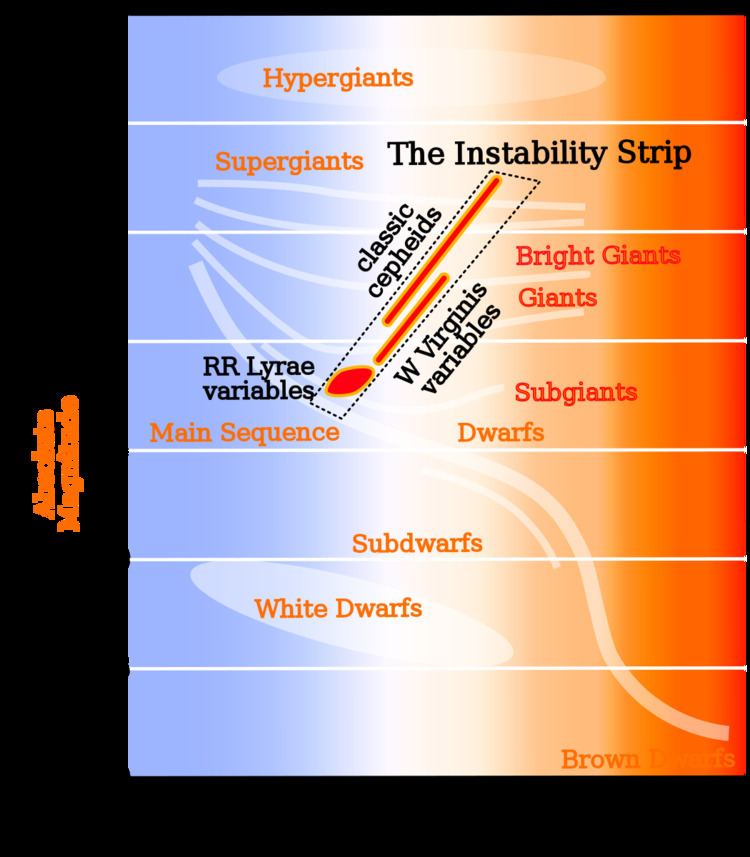 | ||
RR Lyrae variables are periodic variable stars, commonly found in globular clusters and are used as standard candles to measure (extra)galactic distances. This class of variable star is named after the prototype and brightest example, RR Lyrae.
Contents
- Discovery and recognition
- Classification
- Distribution
- Properties
- Period luminosity relationships
- Recent developments
- References
RR Lyraes are pulsating horizontal branch aging stars of spectral class A or F, with a mass of around half the Sun's. They are thought to have previously shed mass during the Red-giant branch phase, and consequently, they were once stars with similar or slightly less mass than the Sun, around 0.8 solar masses.
The period of pulsation and absolute magnitude of RR Lyraes makes them good standard candles for relatively nearby targets, especially within the Milky Way and Local Group. Beyond the Milky Way they are difficult to detect due to their low luminosity. They are extensively used in globular cluster studies, and also used to study chemical properties of older stars.
Discovery and recognition
In surveys of globular clusters, these "cluster-type" variables were being rapidly identified in the mid-1890s, especially by E. C. Pickering.
Probably the first star of definitely RR Lyrae type found outside a cluster was U Leporis, discovered by J. Kapteyn in 1890.
The prototype star RR Lyrae was discovered prior to 1899 by Williamina Fleming, and reported by Pickering in 1900 as "indistinguishable from cluster-type variables".
From 1915 to the 1930s, the RR Lyraes became increasingly accepted as a class of star distinct from the classical Cepheids, due to their shorter periods, differing locations within the galaxy, and chemical differences. RR Lyrae variables are metal-poor, Population II stars.
RR Lyraes have proven difficult to observe in external galaxies because of their intrinsic faintness. (In fact, Walter Baade's failure to find them in the Andromeda galaxy led him to suspect that the galaxy was much farther away than predicted, to reconsider the calibration of Cepheid variables, and to propose the concept of stellar populations.) Using the Canada-France-Hawaii Telescope in the 1980s, Pritchet & van den Bergh found Lyraes in Andromeda's galactic halo and, more recently, in its globular clusters.
Classification
The RR Lyrae stars are conventionally divided into three main types, following classification by S.I. Bailey based on the shape of the stars' brightness curves:
Distribution
RR Lyrae stars were formerly called "cluster variables" because of their strong (but not exclusive) association with globular clusters; conversely, over 80% of all variables known in globular clusters are RR Lyraes. RR Lyrae stars are found at all galactic latitudes, as opposed to classical Cepheids, which are strongly associated with the galactic plane.
Several times as many RR Lyraes are known as all Cepheids combined; in the 1980s, about 1900 were known in globular clusters. Some estimates have about 85000 in the Milky Way.
Though binary star systems are common for typical stars, RR Lyrae are very rarely observed in pairs.
Properties
RR Lyrae stars pulse in a manner similar to Cepheid variables, but the nature and histories of these stars is thought to be rather different. Like all variables on the Cepheid instability strip, pulsations are caused by the κ-mechanism, when the opacity of ionised helium varies with its temperature.
RR Lyraes are old, relatively low mass, Population II stars, in common with W Virginis and BL Herculis variables, the type II Cepheids. Classical Cepheid variables are higher mass population I stars. RR Lyrae variables are much more common than Cepheids, but also much less luminous. The average absolute magnitude of an RR Lyrae star is about +0.75, only 40 or 50 times brighter than our Sun. Their period is shorter, typically less than one day, sometimes ranging down to seven hours. Some RRab stars, include RR Lyrae itself, exhibit the Blazhko effect in which there is a conspicuous phase and amplitude modulation.
Period-luminosity relationships
Unlike Cepheid variables, RR Lyrae variables do not follow a strict period-luminosity relationship at visual wavelengths, although they do in the infrared K band. They are normally analysed using a period-colour-relationship, for example using a Wesenheit function. In this way, they can be used as standard candles for distance measurements although there are difficulties with the effects of metallicity, faintness, and blending. The effect of blending can impact RR Lyrae variables sampled near the cores of globular clusters, which are so dense that in low-resolution observations multiple (unresolved) stars may appear as a single target. Thus the brightness measured for that seemingly single star (e.g., an RR Lyrae variable) is erroneously too bright, given those unresolved stars contributed to the brightness determined. Consequently, the computed distance is wrong, and certain researchers have argued that the blending effect can introduce a systematic uncertainty into the cosmic distance ladder, and may bias the estimated age of the Universe and the Hubble constant.
Recent developments
The Hubble Space Telescope has identified several RR Lyrae candidates in globular clusters of the Andromeda galaxy and has measured the distance to the prototype star RR Lyrae.
The Kepler space telescope provided extended coverage of a single field with accurate photometric data. RR Lyrae itself was in Kepler field of view.
The Gaia mission is expected to greatly improve knowledge of RR Lyraes by providing homogeneous spectrographic information of a large population of such stars.
